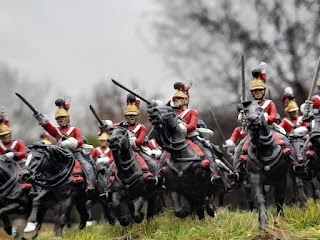Just about scraping in to 2023! Here, finally, are a troop of the 1st Life Guards to round off the year. I've been very busy doing yet another regiment of French line at 1:1 but realised around November I was never going to finish them for the end of the year so switched to these lovely Victrix figs instead.
Here we have 36 men of Lind's Troop. The Troop had a nominal strength of 65 but, with (typically c.15%) non-combatants in the rear, plus the casualties from Genappe on 17th June, this number may not be far off.
Both Life Guard regiments suffered devastating losses over the two days' fighting - and Lind's Troop had 28 casualties from 65 - with 10 killed in action, 3 died of wounds, and another 15 wounded, many of them very seriously.
The 1st Life Guards comprised a large Yorkshire element: from left to right above -
Privates Joseph Bradley (Rudby, Yorks) killed in action; John Higginson (Bradfield, Yorks) killed in action; Christopher Potter (Birstall, Yorks) killed in action; Joseph Liley (Shelley, Yorks) lost his left leg; Thomas Fell (North Dalton, Yorks) died of wounds at Brussels; Peter Seargill (Silkstone, Yorks, killed in action; Stephen Cliffe (Kirkeaton, Yorks), musket ball in left arm "by which both the bones of the left arm were fractured with great consequent debility."
All of the British Household cavalry would have been an extremely formidable sight - these men were, by the standard heights of men in 1815, absolute giants. In a period when, in the average population, fewer than 2 men in 100 were 6 foot tall, a staggering 22 men of Lind's Troop alone were that height or taller. The rest were at least 5'10.
It must have been like seeing a basket ball team crossed with pugilists. Mounted on large horses fresh from London, their sheer size and power must go some way to explaining their devastating impact on the French cuirassiers.
Many men were injured not in direct combat with the enemy but from the fall when their horses fell killed or wounded. Numerous men suffered either fractures or crush injuries - above, for example, we see Private Thomas Gardner (Ulverton, Lancs) who was discharged in 1818 aged 28 "spitting of blood from the lungs by a fall from his horse on his chest at Waterloo". In peacetime he found employment as the drill sergeant of a militia unit only to be killed in 1821 by another fall - The Westmoreland Gazette reports "
On Monday night, as Thos. Gardner, drill sergeant of the Furness Cuirassiers, was returning from exercise at a quick pace; his horse came in contact with a gate which crosses the road leading from Firkrigg to Bardsea, by which it was thrown down with such violence as to fracture the skull of the rider and occasion his instantaneous death."
Many of the Life Guards were long-serving soldiers and had seen service in Portugal and Spain. Above are Privates Joseph Waddington (Thornton, Yorks) who had enlisted in 1799 and was 39 years old in 1815; James Billen (Morton Magnus, Somerset) enlisted 1798 and around 46 years old at Waterloo; and Moses Hercod (Berne, Switzerland) enlisted 1800 and aged 43 at Waterloo. The oldest man in the Troop was Corporal of Horse William Usher (Stourbridge, Worcs), born 1766 he was discharged in 1816 aged 49 in consequence of "decayed constitution from Service abroad".
Despite the advantage of height and weight, the brigade suffered dreadful carnage in the medieval slaughter of close up, hand to hand, fighting. Some of their wounds are of particular interest as they reveal what happened to the British heavy cavalry as they galloped on, failed to regroup, and were consequently overwhelmed by clouds of French line lancers. Above, for example, is Private John Wilson (Douglas, Isle of Man), who suffered a fractured skull and lance wound in shoulder.
All figures are Victrix - beautifully detailed figures and a pleasure to paint. I have misplaced their carbines (I put them "in a safe place"!) so will attach them when they turn up. I also added gauntlets using green stuff.





















No comments:
Post a Comment